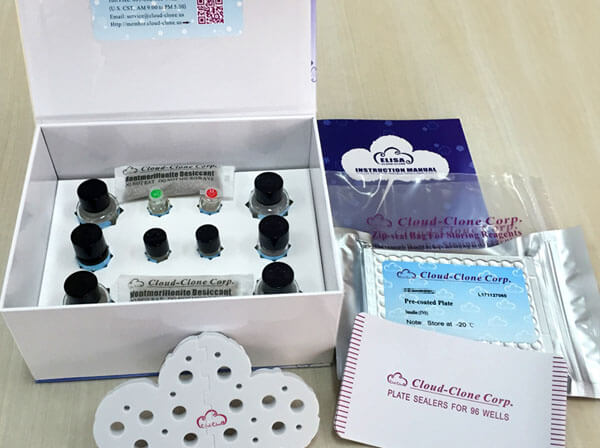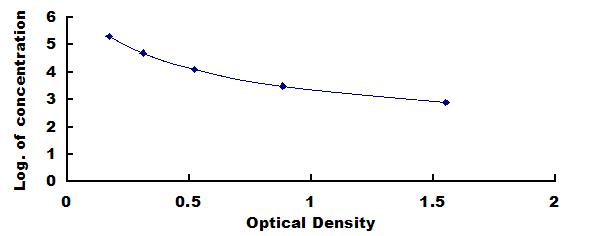ELISA Kit for Alpha-1-Antitrypsin (a1AT) 

SERPINA1; SPAAT; A1-AT; PI; Serpin Peptidase Inhibitor,Clade A(Alpha-1 Antiproteinase/AntiTrypsin)Member 1; Alpha-1 protease inhibitor; Short peptide from AAT; Serpin A1
- UOM
- FOB US$ 532.00 US$ 760.00 US$ 3,420.00 US$ 6,460.00 US$ 53,200.00
- Quantity
Overview
Properties
- Product No.CEB697Ca
- Organism SpeciesCanis familiaris; Canine (Dog) Same name, Different species.
- ApplicationsEnzyme-linked immunosorbent assay for Antigen Detection.
Research use only - DownloadInstruction Manual
- CategoryEnzyme & KinaseInfection immunityHepatology
Sign into your account
Share a new citation as an author
Upload your experimental result
Review

Contact us
Please fill in the blank.
Recovery
Matrices listed below were spiked with certain level of recombinant Alpha-1-Antitrypsin (a1AT) and the recovery rates were calculated by comparing the measured value to the expected amount of Alpha-1-Antitrypsin (a1AT) in samples.
| Matrix | Recovery range (%) | Average(%) |
| serum(n=5) | 97-105 | 102 |
| EDTA plasma(n=5) | 90-97 | 93 |
| heparin plasma(n=5) | 90-104 | 98 |
Precision
Intra-assay Precision (Precision within an assay): 3 samples with low, middle and high level Alpha-1-Antitrypsin (a1AT) were tested 20 times on one plate, respectively.
Inter-assay Precision (Precision between assays): 3 samples with low, middle and high level Alpha-1-Antitrypsin (a1AT) were tested on 3 different plates, 8 replicates in each plate.
CV(%) = SD/meanX100
Intra-Assay: CV<10%
Inter-Assay: CV<12%
Linearity
The linearity of the kit was assayed by testing samples spiked with appropriate concentration of Alpha-1-Antitrypsin (a1AT) and their serial dilutions. The results were demonstrated by the percentage of calculated concentration to the expected.
| Sample | 1:2 | 1:4 | 1:8 | 1:16 |
| serum(n=5) | 88-97% | 81-92% | 94-104% | 92-102% |
| EDTA plasma(n=5) | 91-98% | 80-90% | 96-103% | 82-92% |
| heparin plasma(n=5) | 80-95% | 78-99% | 88-95% | 99-105% |
Stability
The stability of kit is determined by the loss rate of activity. The loss rate of this kit is less than 5% within the expiration date under appropriate storage condition.
To minimize extra influence on the performance, operation procedures and lab conditions, especially room temperature, air humidity, incubator temperature should be strictly controlled. It is also strongly suggested that the whole assay is performed by the same operator from the beginning to the end.
Reagents and materials provided
| Reagents | Quantity | Reagents | Quantity |
| Pre-coated, ready to use 96-well strip plate | 1 | Plate sealer for 96 wells | 4 |
| Standard | 2 | Standard Diluent | 1×20mL |
| Detection Reagent A | 1×120µL | Assay Diluent A | 1×12mL |
| Detection Reagent B | 1×120µL | Assay Diluent B | 1×12mL |
| TMB Substrate | 1×9mL | Stop Solution | 1×6mL |
| Wash Buffer (30 × concentrate) | 1×20mL | Instruction manual | 1 |
Assay procedure summary
1. Prepare all reagents, samples and standards;
2. Add 50µL standard or sample to each well.
And then add 50µL prepared Detection Reagent A immediately.
Shake and mix. Incubate 1 hour at 37°C;
3. Aspirate and wash 3 times;
4. Add 100µL prepared Detection Reagent B. Incubate 30 minutes at 37°C;
5. Aspirate and wash 5 times;
6. Add 90µL Substrate Solution. Incubate 10-20 minutes at 37°C;
7. Add 50µL Stop Solution. Read at 450 nm immediately.

Test principle
This assay employs the competitive inhibition enzyme immunoassay technique. An antibody specific to a1AT has been pre-coated onto a microplate. A competitive inhibition reaction is launched between biotin labeled a1AT and unlabeled a1AT (Standards or samples) with the pre-coated antibody specific to a1AT. After incubation the unbound conjugate is washed off. Next, avidin conjugated to Horseradish Peroxidase (HRP) is added to each microplate well and incubated. The amount of bound HRP conjugate is reverse proportional to the concentration of a1AT in the sample. After addition of the substrate solution, the intensity of color developed is reverse proportional to the concentration of a1AT in the sample.
Giveaways
Increment services
Citations
- Expression and characterization of recombinant human alpha-antitrypsin in transgenic rice seedPubMed: 23376844
- Hepatic steatosis depresses alpha-1-antitrypsin levels in human and rat acute pancreatitisPubMed: 26634430
- Gut Microbial Dysbiosis May Predict Diarrhea and Fatigue in Patients Undergoing Pelvic Cancer Radiotherapy: A Pilot StudyPubMed: 25955845
- Diagnostic Utility of Biomarkers in COPDPubMed: 26106205
- Early prognostic factors in septic shock cancer patients: a prospective study with a proteomic approachPubmed:29315472
- Urinary Proteomics for the Early Diagnosis of Diabetic Nephropathy in Taiwanese PatientsPubmed: 30486327
- Salivary proteins from dysplastic leukoplakia and oral squamous cell carcinoma and their potential for early detectionPubmed: 31706945
- Systemic Alterations of Immune Response-Related Proteins during Glaucoma Development in the Murine Model DBA/2JPubmed: 32585848
- Prenatal diagnosis of maternal serum from mothers carrying β‐thalassemic fetus34559910

















